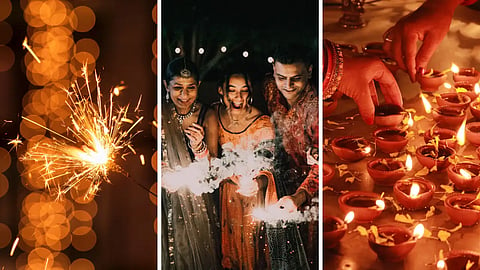
- Home
- Live Blog
- Breaking News
- Top Headlines
- Cities
- NE News
- Sentinel Media
- Sports
- Education
- Jobs

Dr Priyanka Saurabh
(laloo.barwa@yahoo.in)
Festivals are the soul of our society—a time when people express gratitude to God, nature, and their relationships. But now, a new character has joined every festival—the mobile camera. As soon as the lamp is lit, the aarti plate is rotated, or a rakhi is tied, the first question is, “Did you take a photo?” Previously, the puja was completed, followed by the prasad distribution; now, the story is made first, followed by the puja. This is the same India where what was once a “festival of the mind” has now become a “festival of the media”.
Diwali is no longer a night of lights but of posts about decorations. People are more preoccupied with perfecting camera angles than cleaning their homes. Before worshipping the idol of Goddess Lakshmi, a ‘boomerang’ is created, and before bursting firecrackers, a ‘caption’ is decided—#Diwali_vibes #family_love. It seems as if everyone’s festival must be reflected on social media, or else it’s incomplete. This digital competition has become more about ‘likes’ than devotion.
The spirit of fasts like Karva Chauth—love, devotion, and blessings—has now been subsumed into photo ops and discount offers. Trends like “selfie with mother-in-law”, “fasting face”, and “photo with the moon” have become the new hallmarks of the festival. Earlier, there was the thrill of seeing the moon; now there is the obsession with clicking. There was a time when women wore saris with a sense of worship; today, the same saris have become a means of branding. The festival has now become a festival of display, not love.
Holi is no longer a game of colours but of colourful displays. Faces that used to be drenched in colour are now washed away by filters. People are now more afraid of applying colour to each other, fearing, “I’ll ruin my clothes and look bad in photos.”
“Selfie with Gulal” has colours but no sense of belonging. This Holi has become a Holi of makeup, not of the heart.
Eid, Christmas, Navratri—celebrations of every religion are now painted in the same colour—the colour of digital ostentation. Smiling pictures in front of a mosque or church, photos of dishes lined up on a plate, and the caption—“Sharing love and peace.” But are they truly spreading love and peace, or is it just a sham? Instead of uniting people, festivals are now becoming a source of comparison and competition. “His lighting is more beautiful.” “His pavilion is bigger.” “She has more expensive decorations”—all this has swallowed up the intimacy that once defined families.
This selfie drama has become so profound that even devotion is now a play. Upon entering a temple, people first pull out their phones, then fold their hands. Aarti is performed live, but the mind is offline. Donations are displayed on social media so that others know that they, too, are virtuous. Devotion is no longer private; it has become a public display. Faith is no longer driven by the soul but by broadcast.
From a psychological perspective, this “digital faith” is the result of a deep unease. People now seek proof of every experience through social media. They believe that if something doesn’t catch the camera, it never happened. This is why smiles during festivals are practised, not genuine. Even children have learnt to say “Happy Diwali” in front of the camera. The warmth of relationships has now been frozen by the cold of the camera.
That was the true meaning of festivals—to stop, to breathe, and to connect.
Now the meaning has changed – decorate, post, forget. People don’t even remember the original purpose of the festival—all they remember is what to post on which day. This “selfie culture” is slowly eroding the spiritual depth that once defined Indian society.
Now festivals have become a mirror of the ‘image’, not of the soul.
The market also did not take long to capitalise on this trend.
Before every festival, there is a flood of ‘selfie backgrounds’, ‘photo platforms’, ‘digital decorations’ and ‘festival collections’.
Packaging has become more important than the puja thali. Festivals have become branded occasions, not spiritual ones. Diwali is now an “online shopping festival”, Navratri is a “sponsored Garba Nights event”, and Holi has become a “colour blast event”. Where festivals once purified the soul, they now empty the wallet.
This competition for showing off on social media has created a strange emotional distance in society. People think they’ve connected with others by looking at their photos—when in reality, that connection is an illusion. Festivals that once brought people together are now isolating people. Everyone is engrossed in their phones, each other’s presence only on a screen. The “family photo” is complete, but the family is fragmented.
Writing all this, a question lingers—are we connecting with God or with network signals? Are we finding joy or simply a ‘reaction’? Could it be that our festivals are now illuminated not by soul but by camera flashes?
The true meaning of festivals will return when we put down the camera and see a genuine smile on someone’s face.
When diyas are lit not just for photos, but for darkness. When Karva Chauth is celebrated with no photos, but rather with people sitting together and finding solace in each other’s eyes. When Holi brings colours, not fear, but a sense of belonging. Festivals will return when we stop showing—and start feeling. This selfie drama of festivals will end only when a person can look within himself and say – “I don’t need anyone’s likes, I just need the genuine smile of my loved ones.”